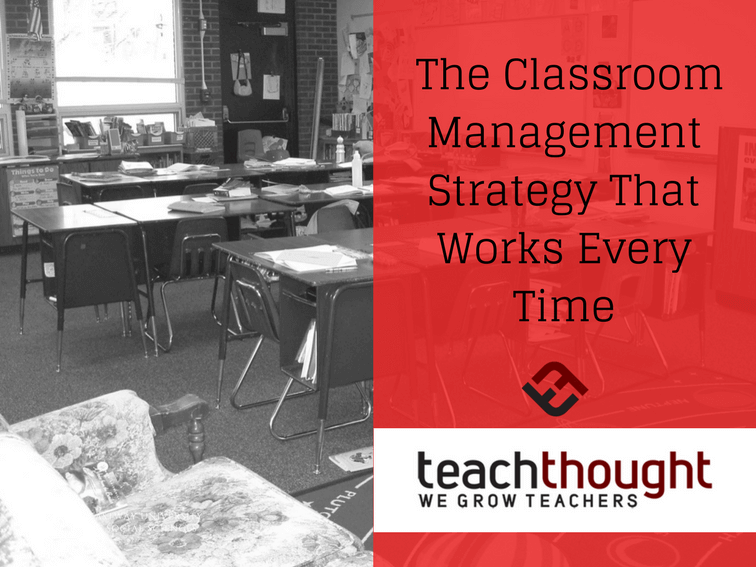
This Classroom Management Strategy Works Every Time
contributed by Dominique Smith
Just like every student wonders what their teachers will be like this school year, teachers are similarly curious.
This curiosity builds over the years, often catalyzed by the fear of failure.
What if I fail?
What if my lessons don’t ‘work’?
What if my students dislike me?
These are the questions that run through our minds until we are in our classrooms with our new students.
As I think of classroom management and the strategies that go into making a positive classroom community, my first thought is relationships. Relationships are key to building classroom norms and classroom expectations–maybe your most powerful tool as a teacher.
The simple truth reveals itself every year: If you have strong relationships with students who care about you as well as respect you, you will have fewer issues within your classroom. When a student has a relationship with you they choose to act differently because of, among other emotions, the fear of losing the relationship.
It’s no different for adults. There are people in your life right now that you act differently because you don’t want to lose the relationship you have with them. Think of how often, as an adult, you have to bite your tongue or turn the other cheek to maintain an important relationship–personal and professional.
I see this happen all the time in classrooms. Over me over again, students make different choices because they want to keep their relationship with you.
How To Hurt Your Relationship With A Student
So how do you lose relationships–and the structure of your classroom? By making students feel ‘less’ than themselves. For example, a behavior chart helps set expectations with the classroom, but it also calls for us to build students’ identity in a negative way.
In my son’s class, his clip chart is Rainbow Day, Sunny Day, Cloudy Day, and Stormy Day. If he does well he is a rainbow kid and if he does bad he is a stormy kid. I have experienced is the excitement of my son running through the door to tell me he had a ‘rainbow day.’ This is always a high five moment in our house!
The other side of this is that right after he shares that he was a ‘rainbow’ he can then ramble off a list of students that were ‘storms.’ While we set a kind of expectation, we have unwittingly placed these students in categories of ‘good’ and ‘bad,’ and at a young age helped them begin to build their identity as a ‘bad kid.’ If we insist on this approach, the least we can do is hold students accountable in a private way.
In upper grades, we have done away with the behavior charts. Right? We’ve actually just made them verbal and ongoing. When we call a student out in class, we are actually doing the same thing as a behavior chart. We are making a student feel uncomfortable, and perhaps even shame and humiliation. And when we call students out to ‘fix behavior,’ we are actually losing control of our whole classroom because now not just one student is off task, the whole class is.
When we call a student out every other student wants to see what is going on, so they turn their heads and look. What we tend to see next is the group of students that ‘missed’ what was going on and now have to ask everyone around them what happened. This is now taking away from instruction again–and make your job more difficult as a teacher.
Why not handle the situation with the student privately. How? When you see a student off task, ask your students to talk about whatever you were reviewing and slowly walk over to that student. Kneel down next to that student and have a conversation with them to help them focus on getting back on track while the other students are working. Some may notice, but it won’t be near the distraction it would’ve been during whole-class activities.
The One Classroom Management Strategy That Works Every Time
We never want to give a student an opportunity to be defiant, but when we call them out we are inviting confrontation. Students respond differently when they feel attacked, just like adults.
The one classroom management tip that works every time? Build relationships. Make every to make an effort to get to know your students–especially on their ‘turf’ and in non-academic ways. What are they interested in? What do they love?
We have to work on building relationships. No matter what we personally believe about discipline, respect, and other factors of raising strong children into strong adults, we have to realize that the world we were raised in is gone, just as the world before it was gone when we were in school.
It seems like common sense, but work to reduce the opportunity of conflict through strong, authentic relationships with students.
One statement that has allowed me to grow as an educator and what has helped me in times of struggle with students? ‘A child doesn’t learn from a teacher they don’t like.’ Even if it’s not always true, there are other theories that make more sense to work to prove or disprove in your classroom.
Dominique Smith is a social worker, school administrator, mentor, national trainer for the International Institute on Restorative Practices, and member of ASCD’s FIT Teaching (Framework for Intentional and Targeted Teaching®) Cadre.
He is the coauthor of the ASCD books Better than Carrots and Sticks: Restorative practices for positive classroom management, a coauthor of Building Equity: Building Policies and Procedures to empower all students, and has written articles for Principal Leadership and School Leadership
